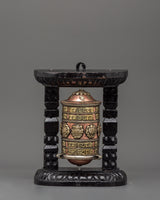
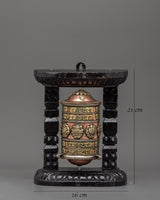
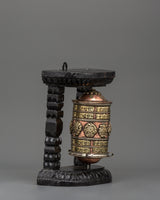
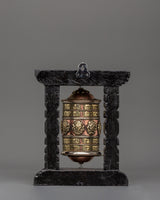
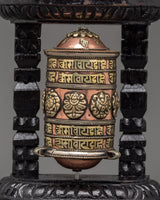
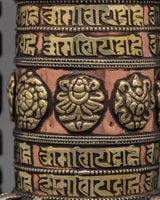
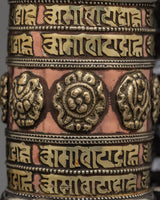
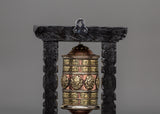
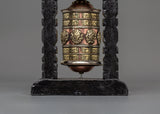
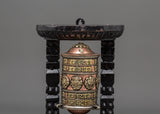
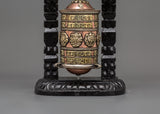
Sacred Tibetan Prayer Wheel | Wood Frame for Ritual Use
Sacred Tibetan Prayer Wheel - Wood Frame for Ritual Use
--------------------------------------------------------
Size: 21cm(Height) x 16cm(Width)
Weight: 0.50kg
Materials: Copper Body, Brass Body, Wood
--------------------------------------------------------
About our Prayer Wheel
With the guidance of this exquisitely crafted sacred Tibetan Prayer Wheel, you can channel inner serenity and holy blessings. This spiritual tool, which stands 21 cm tall, has a plated copper body with intricate flower emblems and engraved Sanskrit mantras set within a carefully crafted wooden frame. The writing surrounding the wheel contains profound blessings, generally thought to cleanse bad karma and foster compassion, wisdom, and balance.
This prayer wheel is a valuable and significant addition to any meditation altar or spiritual area, expertly crafted from a harmonic combination of copper and brass. Both aesthetic appeal and calming benefits are provided by the intricate design and well-balanced structure (weighing 0.50kg). The wheel's durability and religious appeal are enhanced by its wooden frame, which makes it an ideal addition to everyday routines or a considerate present for spiritual seekers. Sacred mantras are invoked with each wheel spinning, energizing and elevating the soul.
Introduction to Prayer Wheel
A prayer wheel is cylindrical on a spindle and is used in Tibetan Buddhism. It is typically inscribed with the mantra "Om Mani Padme Hum" and rotated by hand as a form of spiritual practice and to accumulate merit. Spinning the wheel is believed to have the same spiritual benefits as verbally reciting the mantra. The use of prayer wheels is widespread in Tibetan Buddhism and has spread to other cultures.
How does the Buddhist Prayer Wheel benefit us?
The benefits associated with rotating the wheel are numerous. It promotes knowledge, compassion, and bodhicitta in the practitioner and improves siddhis (spiritual powers such as clairvoyance, precognition, etc.). The practitioner can repeat the mantra as often as possible while the wheel is rolling, maintaining a calm, meditative attitude. A Tibetan Buddhist tradition holds that after a practice session, one should dedicate any acquired merits to the benefit of all sentient beings. Then three times Om Ah Hum. This is usually among Tibetans after finishing any Buddhist practice, including the prayer wheel exercise.
How do you set up your own Buddhist Shrine?
• Find a clean, quiet, and uncluttered spot
• Set up an altar table and cover it with an altar cloth that calls to you
• Place your sacred item at the center

















